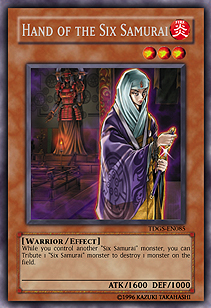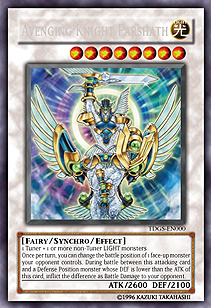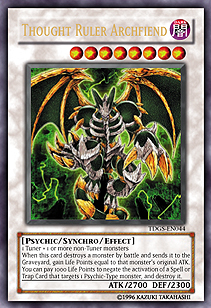If I were to say that players frequently (and grossly) exaggerate the cost of most secret rares on the secondary market, it would be a severe understatement. In the grand scheme of things, most decks are a lot easier to put together than many players want to admit. After all, if they recognized that there are options other than Gladiator Beasts that don’t use a full suite of Allure of Darkness, Destiny Draw, Destiny Hero - Malicious, and a pair of Dark Armed Dragon cards along with Crush Card Virus, what would there be to complain about? Not very much from what I can see, but when all else fails, people resort to grumbling about how "stale" the metagame is or how the Forbidden list "killed" their favorite deck. The first claim is laughable in a format that’s had four different decks make Day 2 of each of the Shonen Jump Championships thus far (especially when it wasn’t even the same four decks). The second is actually debatable. Decks come and go all the time—usually due to new card releases—but sometimes a change to the most recent Forbidden and Limited list makes a particular popular strategy impossible or unviable. In the case of "Sack Samurai," the Limiting of Reasoning made it all but impossible to dump four monsters on the field in one turn just because your opponent made an incorrect guess at an arbitrary number. From where I’m sitting, that’s not really a bad thing.
Instead of outright killing the Six Samurai strategy, I think the Limitation of Reasoning gave it an opportunity to redefine itself in a way that players will actually appreciate. While they lost some of their explosive potential, Six Samurai players will be able to supplement it with added consistency and even more field control in the form of a third Reinforcement of the Army card, the addition of Synchro monsters, and the new secret rare, Hand of the Six Samurai. Sure, you won’t have Emergency Teleport and Malicious there to fuel multiple first-turn Synchro summons, but you can set up your deck in such a way that you’ll be able to perform up to eight Synchro summons in a single duel. It’s a feat that TeleDAD simply can’t pull off in its current form.
Even better, each of the Six Samurai has a purpose on its own outside of being used to fuel other summons and effects, making the deck work with almost any combination of cards that you happen to draw. With the new collector’s tins, exclusive tins, the Gold Series reprint of Grandmaster of the Six Samurai, the common and rare status of most of the basic cards of the deck, and the fact that Hand of the Six Samurai is not Charge of the Light Brigade, the materials for a Six Samurai deck are readily available to anyone who wants them. Here’s how I would approach the deck.

Monsters: 21
3 Grandmaster of the Six Samurai
1 The Six Samurai - Irou
3 The Six Samurai - Zanji
3 The Six Samurai - Yaichi
2 Hand of the Six Samurai
2 Spirit of the Six Samurai
2 Junk Synchron
3 Jutte Fighter
Spells: 10
3 Reinforcement of the Army
3 Six Samurai United
1 Monster Reborn
1 Heavy Storm
1 Mystical Space Typhoon
1 Brain Control
Traps: 10
2 Bottomless Trap Hole
3 Dimensional Prison
3 Solemn Judgment
2 Double-Edged Sword Technique

Extra Deck: 15
3 Goyo Guardian
2 Stardust Dragon
3 Thought Ruler Archfiend
2 Colossal Fighter
1 Red Dragon Archfiend
1 Avenging Knight Parshath
Most Six Samurai decks play two basic games: the ones where they draw Grandmaster of the Six Samurai and the ones where they lose. One of the key features of this deck is that it can survive through the crucial first turns even if it can’t drop a Samurai with Grandmaster on turn 1. The extra resiliency comes from the trap lineup, which contains both Bottomless Trap Hole and a full complement of Dimensional Prison cards alongside Solemn Judgment. Depending on whether or not they managed to get Malicious into the graveyard, the TeleDAD deck will drop either Goyo Guardian or Stardust Dragon. Goyo Guardian will fall into anything you’ve got, but if the deck was only running Bottomless Trap Hole as removal, you’d be out of luck every time you didn’t have a Solemn Judgment down. By definition, you don’t have a Solemn Judgment down on the very first turn of the game, and that makes the ability to set Dimensional Prison when you do get a turn that much better. Attack and pass won’t work if you have a Prison down, so if your opponent can’t force through Dark Armed Dragon right then and there, he or she is going to be down a Stardust Dragon very shortly.
Those same trap cards also give you a much better game against Gladiator Beasts. Gladiator Beast War Chariot only works if your opponent can bring down a Gladiator Beast and make it stick. Bottomless Trap Hole and Solemn Judgment prevent him or her from getting a monster to the field in the first place, and once again, Dimensional Prison is the star of the show: eliminating anything that dares attack you. It’s especially useful in protecting smaller Samurai like Yaichi from being run down by a drawn copy of Gladiator Beast Darius.
What happens, though, if everything goes horribly wrong and your opponent manages to drop Gladiator Beast Heraklinos or multiple Synchro monsters at the same time? Enishi, Shien’s Chancellor is the answer. In the case of Heraklinos, if Enishi gets to the field and your opponent has a spell or trap card set, it’s probably a War Chariot. In this case you’ll want to have Jutte Fighter join it for a Synchro summon to bring out Colossal Fighter. With all the Warriors in your deck you’re guaranteed to have a Colossal Fighter that has ATK at least equal to Heraklinos’s. Especially in the case where you have equal ATK, that Gladiator Beast player is hosed, and Chariot wouldn’t even help. If your opponent doesn’t have a back-row card though, just blow Heraklinos away and continue doing what you’re doing. Perform a Synchro summon, or play some more Samurai: your opponent won’t have any way to stop you.
Fields full of Synchro monsters and Dark Armed Dragon cards are a lot harder to deal with because of Stardust Dragon. Obviously, you can’t just drop Enishi and try to blow up Dark Armed Dragon with Stardust Dragon around. What you can do is execute a play that will take out both of the Dragons. In this case, you’ll want to have Jutte Fighter in the graveyard, which is reasonable considering that it’s usually about mid-game when Dark Armed Dragon makes an appearance. You’ll summon Enishi like before, and then play Junk Synchron to revive Jutte Fighter. The Fighter’s effect might be negated, but since Enishi is a Light monster you can Synchro summon Avenging Knight Parshath. Parshath switches Dark Armed Dragon to defense so that Junk Synchron can slay it while Parshath strikes down Stardust Dragon. Even if your opponent has one huge monster left, it’s now the singular target for Dimensional Prison.
The interactions between Hand of the Six Samurai, Spirit of the Six Samurai, and Double-Edged Sword Technique are fairly well known by now. With one Samurai on the field, Double-Edged Sword Technique can turn on your Samurai effect, let you destroy up to two monsters if you bring back Hand, and let you destroy a monster and turn your remaining Samurai into a card-drawing berserker if you bring back Spirit of the Six Samurai. You also won’t take any damage in the end phase because your monsters are either back in the graveyard already or no long being treated as monsters.
There’s one other thing that you can do with Double-Edged Sword Technique, and that’s set up for an easy Synchro summon. Bringing back two level 3 Samurai makes it simple to drop  and bring out a level 8. If you bring back Grandmaster and a level 4 Samurai, Junk Synchron pulling back Jutte Fighter converts into a level 8 Synchro monster and Goyo Guardian. My personal favorite is using the Junk Synchron into Jutte Fighter combination to turn Yaichi and Grandmaster into Thought Ruler Archfiend and Magical Android. You’ll gain a minimum of 1200 life points per turn while maintaining the threat of a nasty negation ability.
and bring out a level 8. If you bring back Grandmaster and a level 4 Samurai, Junk Synchron pulling back Jutte Fighter converts into a level 8 Synchro monster and Goyo Guardian. My personal favorite is using the Junk Synchron into Jutte Fighter combination to turn Yaichi and Grandmaster into Thought Ruler Archfiend and Magical Android. You’ll gain a minimum of 1200 life points per turn while maintaining the threat of a nasty negation ability.
It probably seems like I was outright neglecting most of the Samurai effects over the last thousand words, but it’s primarily because you already know they’re good. Destroying monsters is good. Blasting set spell and trap cards is good. Making your other Samurai bigger and giving them a card-drawing ability is good. It’s the things that support these cards and make up for the weaknesses they have that makes this deck good. With three copies of Reinforcement of the Army, having the right cards for the job becomes so much easier than it used to be. Combine it with three copies of Six Samurai United, and your chances of having what you need to win skyrockets even higher. This deck is an exercise in taking cards you might have thought were going to disappear and making them even better instead of storing them in some old shoebox. Hopefully many of you out there are doing the same thing with your favorite cards right now. Until next time, play hard, play fair, and most importantly, have fun!
—Jerome McHale